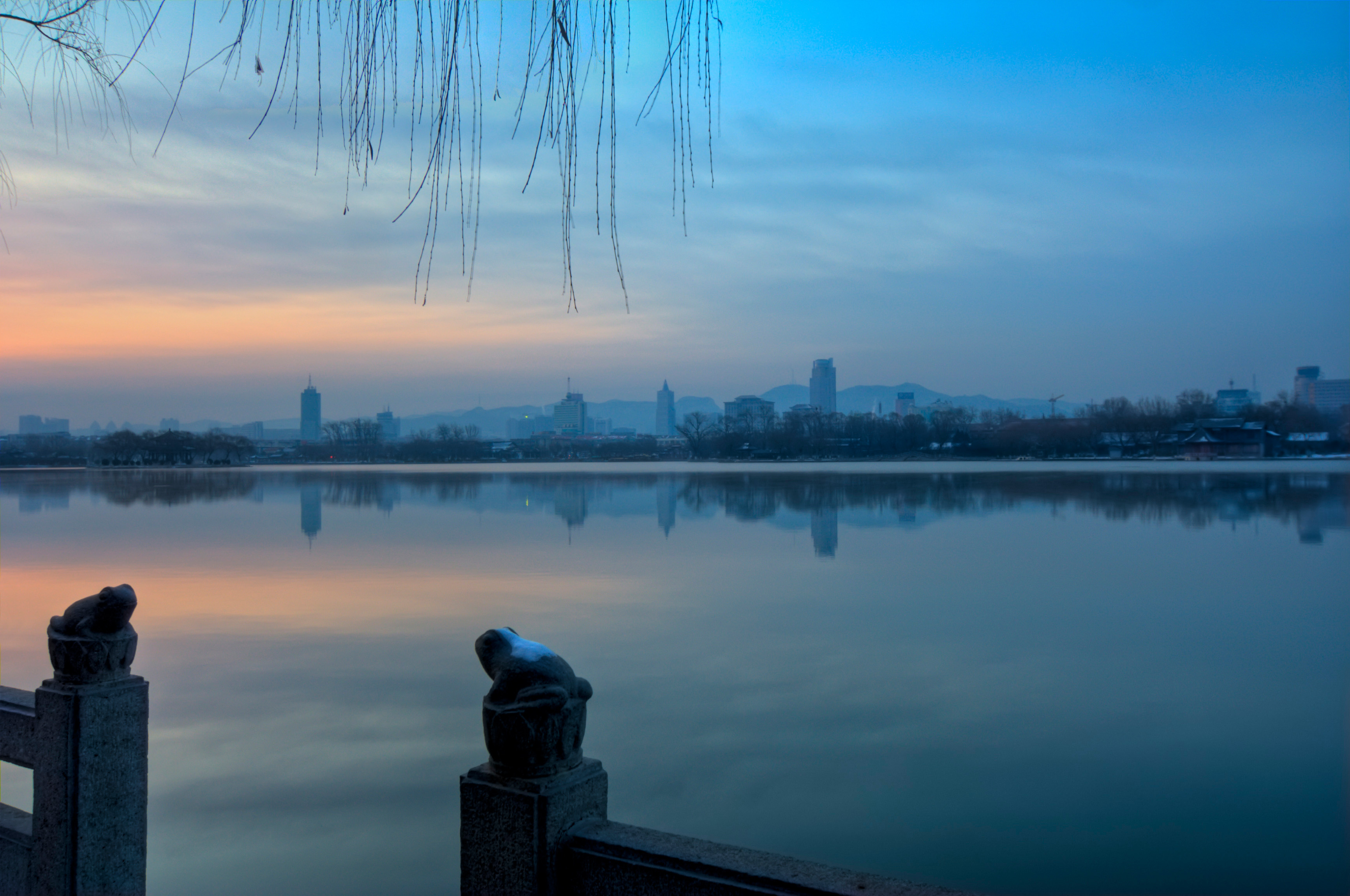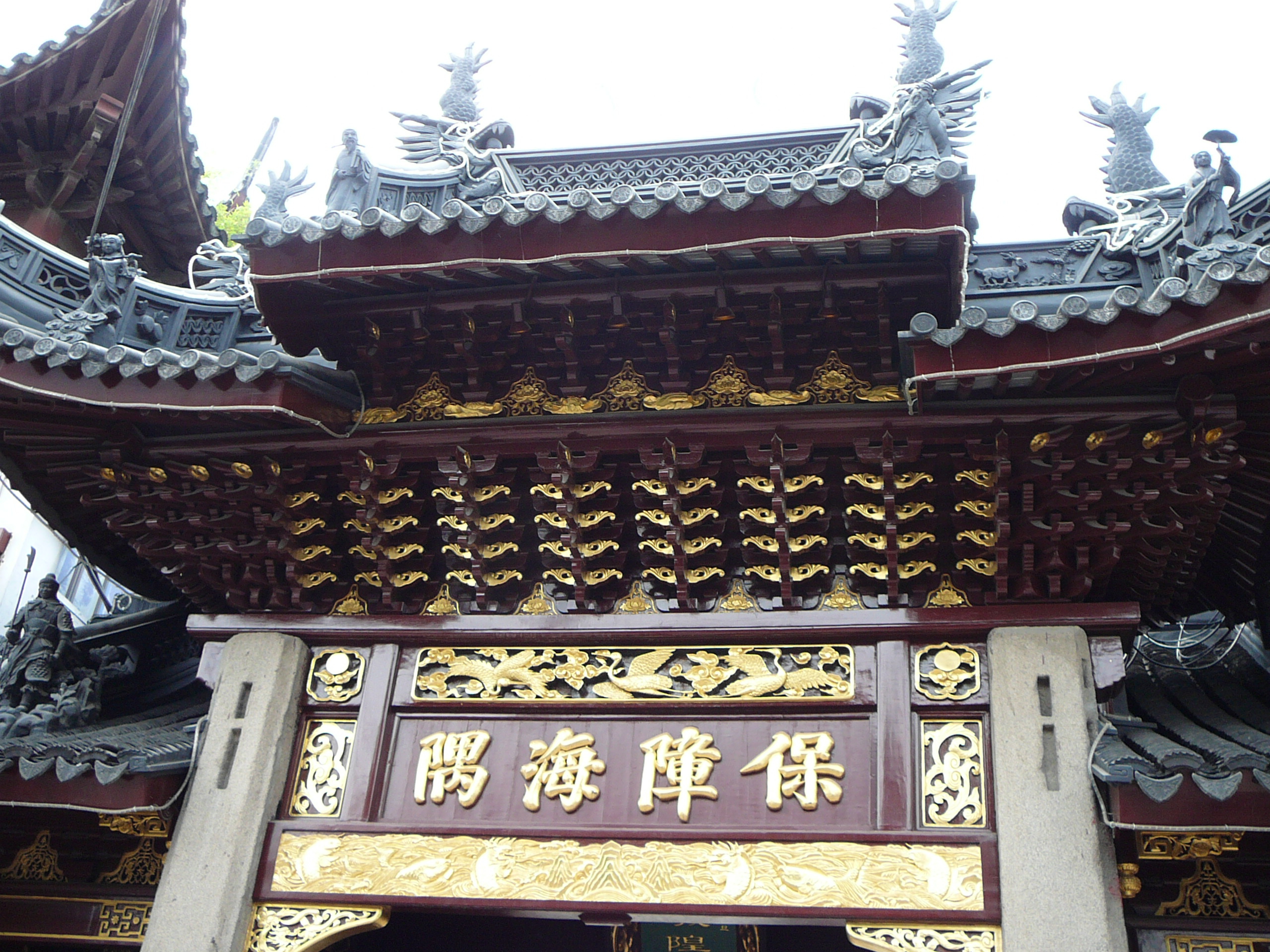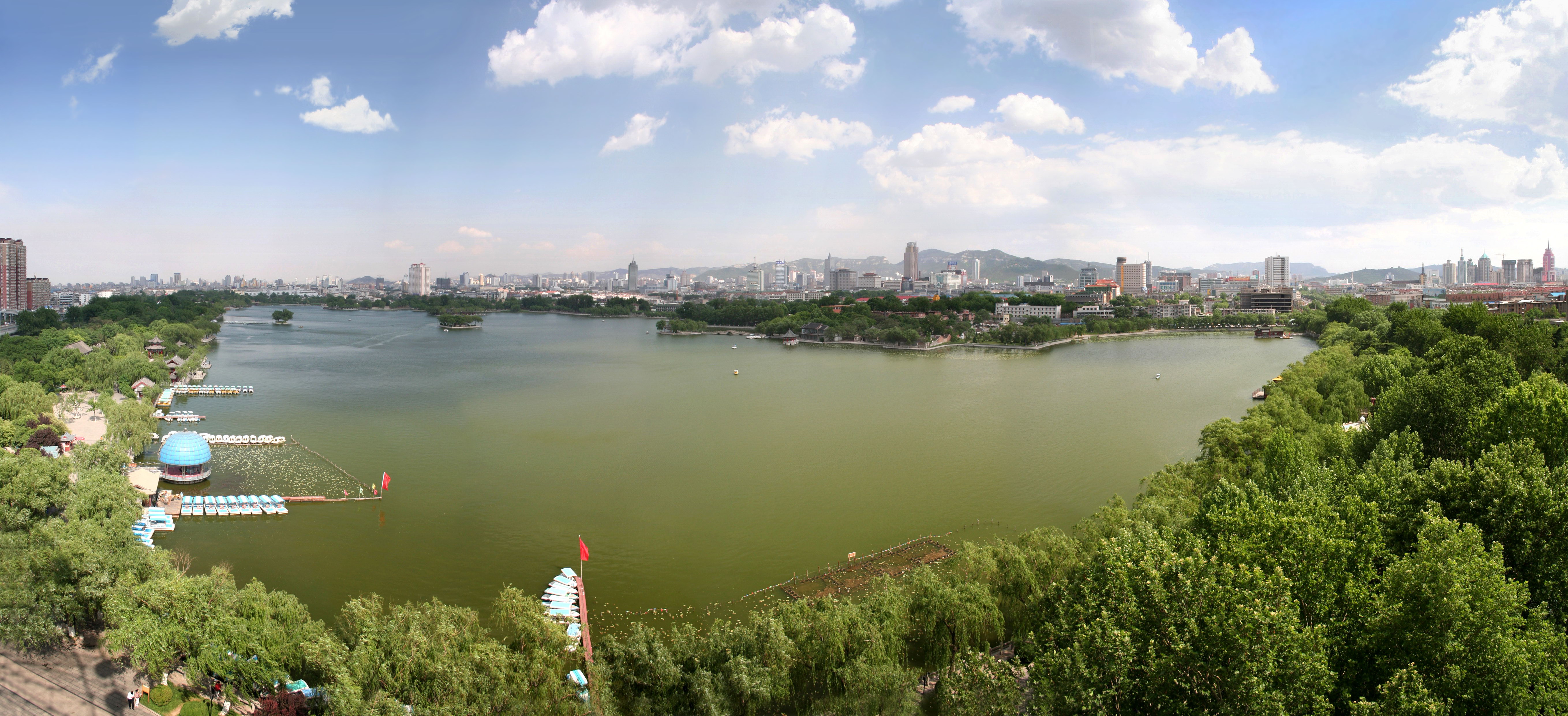|
Daming Lake
Daming Lake () is the largest lake in the city of Jinan, capital of Shandong, China and one of city's main natural and cultural landmarks and tourist attraction. Located to the north of the historical city center, the lake is fed by the artesian karst springs of the area and hence retains a fairly constant water level through the entire year. Islands Located in the lake are nine small islands: *Cuiliuping Island (), also known as () *Niaoqingqiqi Island () *Guting Island (), the location of the Lixia Pavilion *Mingshi Island () *Huiquan Island () *Huxin Island () *Jiaxuan Island () *Qiuliu Island () *Huju Island () Buildings The lake is surrounded by a park with an ensemble of historical buildings, some of which stand on the islands in the lake: Lixia Pavilion The Lixia Pavilion () is located on an island off the lake's east shore. The pavilion is said to mark the spot of a meeting between the Tang dynasty poet Du Fu and the calligrapher Li Yong (, 678–747). The pavilion was ... [...More Info...] [...Related Items...] OR: [Wikipedia] [Google] [Baidu] |
Paifang
A ''paifang'', also known as a ''pailou'', is a traditional style of Chinese architecture, often used in arch or gateway structures. Etymology The word ''paifang'' ( zh, c=牌坊, p=páifāng) was originally a collective term for the top two levels of administrative division and subdivisions of ancient Chinese cities. The largest division within a city in ancient China was a ''fang'' ( zh, c=坊, hp=fāng, labels=no), equivalent to a current day ward (electoral subdivision), ward. Each ''fang'' was enclosed by walls or fences, and the gates of these enclosures were shut and guarded every night. Each ''fang'' was further divided into several ''pai'' ( zh, c=牌, hp=pái, l=placard, labels=no), which is equivalent to a current day (unincorporated) community. Each ''pai'', in turn, contained an area including several hutongs (alleyways). This system of urban administrative division and subdivision reached an elaborate level during the Tang dynasty, and continued in the following dy ... [...More Info...] [...Related Items...] OR: [Wikipedia] [Google] [Baidu] |
Ancestral Hall
An ancestral shrine, hall or temple ( or , ; Chữ Hán: ; ), also called lineage temple, is a temple dedicated to deified ancestors and progenitors of surname lineages or families in the Chinese tradition. Ancestral temples are closely linked to Confucian philosophy and culture and the emphasis that it places on filial piety. A common central feature of the ancestral temples are the ancestral tablets that embody the ancestral spirits.Edward L. Davis (Editor), Encyclopedia of Contemporary Chinese Culture, Routledge, 2004 The ancestral tablets are typically arranged by seniority of the ancestors. Altars and other ritual objects such as incense burners are also common fixtures. Ancestors and gods can also be represented by statues. The temples are used for collective rituals and festivals in honor of the ancestors but also for other family- and community-related functions such as weddings and funerals. Sometimes, they serve wider community functions such as meetings and loca ... [...More Info...] [...Related Items...] OR: [Wikipedia] [Google] [Baidu] |
Xiaoqing River
Xiaoqing River () is a river in Shandong Province, China. It is part of the Bohai Sea basin and empties into Laizhou Bay. The river flows through the major city of Jinan. It is long and drains a basin, which also contains the city of Zibo. Ecology The river has been noted as a major source of pollution in Laizhou Bay, with pollution control efforts influencing the abundance of phytoplankton Phytoplankton () are the autotrophic (self-feeding) components of the plankton community and a key part of ocean and freshwater Aquatic ecosystem, ecosystems. The name comes from the Greek language, Greek words (), meaning 'plant', and (), mea ... species in the estuary. See also * List of rivers in China References Rivers of Shandong {{China-river-stub ... [...More Info...] [...Related Items...] OR: [Wikipedia] [Google] [Baidu] |
Daming Lake
Daming Lake () is the largest lake in the city of Jinan, capital of Shandong, China and one of city's main natural and cultural landmarks and tourist attraction. Located to the north of the historical city center, the lake is fed by the artesian karst springs of the area and hence retains a fairly constant water level through the entire year. Islands Located in the lake are nine small islands: *Cuiliuping Island (), also known as () *Niaoqingqiqi Island () *Guting Island (), the location of the Lixia Pavilion *Mingshi Island () *Huiquan Island () *Huxin Island () *Jiaxuan Island () *Qiuliu Island () *Huju Island () Buildings The lake is surrounded by a park with an ensemble of historical buildings, some of which stand on the islands in the lake: Lixia Pavilion The Lixia Pavilion () is located on an island off the lake's east shore. The pavilion is said to mark the spot of a meeting between the Tang dynasty poet Du Fu and the calligrapher Li Yong (, 678–747). The pavilion was ... [...More Info...] [...Related Items...] OR: [Wikipedia] [Google] [Baidu] |
Drum Tower (Asia)
A drum tower () or gulou is a tower in the center of an old Asian city or village, mainly China, housing Drum (communication), signal drums. There was usually also a bell tower nearby. They were once found all over China in villages, marking the symbolic center of the settlement and used to mark nightfall and to summon the people for civic ceremonies and significant occasions, such as Chinese New Year. The drum tower often being located in the symbolic center of a city, downtown districts of several Chinese cities have been named after the tower. See also * Drum tower (Chinese Buddhism), a different type of drum tower Individual drum towers * Gulou and Zhonglou (Beijing) (Drum Tower and Bell Tower of Beijing) * Drum Tower of Xi'an * Drum Tower of Nanjing * Bianjing Drum Tower References Architecture in China Drum towers, * Towers Traditional East Asian architecture {{PRChina-struct-stub ... [...More Info...] [...Related Items...] OR: [Wikipedia] [Google] [Baidu] |
Yuan Dynasty
The Yuan dynasty ( ; zh, c=元朝, p=Yuáncháo), officially the Great Yuan (; Mongolian language, Mongolian: , , literally 'Great Yuan State'), was a Mongol-led imperial dynasty of China and a successor state to the Mongol Empire after Division of the Mongol Empire, its division. It was established by Kublai (Emperor Shizu or Setsen Khan), the fifth khagan-emperor of the Mongol Empire from the Borjigin clan, and lasted from 1271 to 1368. In Chinese history, the Yuan dynasty followed the Song dynasty and preceded the Ming dynasty. Although Genghis Khan's enthronement as Khagan in 1206 was described in Chinese language, Chinese as the Han Chinese, Han-style title of Emperor of China, Emperor and the Mongol Empire had ruled territories including modern-day northern China for decades, it was not until 1271 that Kublai Khan officially proclaimed the dynasty in the traditional Han style, and the conquest was not complete until 1279 when the Southern Song dynasty was defeated in t ... [...More Info...] [...Related Items...] OR: [Wikipedia] [Google] [Baidu] |
Xuan Wu (god)
Xuanwu () or Xuandi (), also known as Zhenwu (, ) or Zhenwu Dadi (, ), is a revered deity in Chinese religion, one of the higher-ranking deities in Taoism. He is revered as a powerful god, able to control the elements and capable of great magic. He is identified as the god of the north ''Heidi'' (, ) and is particularly revered by martial artists. He is the patron god of Hebei, Henan, Manchuria and Mongolia. As some Han Chinese (now the modern-day Cantonese and Fujianese peoples) migrated into the south from Hebei and Henan during the Tang-Song era, Xuanwu is also widely revered in the Guangdong, Guangxi and Fujian provinces, as well as among the overseas diaspora. Since the usurping Yongle Emperor of the Ming dynasty claimed to receive the divine assistance of Xuanwu during his successful Jingnan Campaign against his nephew, he had a number of Taoist monasteries constructed in the Wudang Mountains of Hubei, where Xuanwu allegedly attained immortality. According to Taoist be ... [...More Info...] [...Related Items...] OR: [Wikipedia] [Google] [Baidu] |
Taoism
Taoism or Daoism (, ) is a diverse philosophical and religious tradition indigenous to China, emphasizing harmony with the Tao ( zh, p=dào, w=tao4). With a range of meaning in Chinese philosophy, translations of Tao include 'way', 'road', 'path', or 'technique', generally understood in the Taoist sense as an enigmatic process of transformation Ultimate reality, ultimately underlying reality. Taoist thought has informed the development of various practices within the Taoist tradition and beyond, including forms of Taoist meditation, meditation, Chinese astrology, astrology, qigong, feng shui, and Neidan, internal alchemy. A common goal of Taoist practice is self-cultivation, a deeper appreciation of the Tao, and more harmonious existence. Taoist ethics vary, but generally emphasize such virtues as ''wu wei, effortless action'', ziran, ''naturalness'', ''pu (Taoism), simplicity'', and the Three Treasures (Taoism), three treasures of compassion, frugality, and humility. The co ... [...More Info...] [...Related Items...] OR: [Wikipedia] [Google] [Baidu] |
Yongle Emperor
The Yongle Emperor (2 May 1360 – 12 August 1424), also known by his temple name as the Emperor Chengzu of Ming, personal name Zhu Di, was the third List of emperors of the Ming dynasty, emperor of the Ming dynasty, reigning from 1402 to 1424. He was the fourth son of the Hongwu Emperor, the founding emperor of the dynasty. In 1370, Zhu Di was granted the title of Prince of Yan. By 1380, he had relocated to Beijing and was responsible for protecting the northeastern borderlands. In the 1380s and 1390s, he proved himself to be a skilled military leader, gaining popularity among soldiers and achieving success as a statesman. In 1399, he rebelled against his nephew, the Jianwen Emperor, and launched a civil war known as the Jingnan campaign, or the campaign to clear away disorders. After three years of intense fighting, he emerged victorious and declared himself emperor in 1402. After ascending the throne, he adopted the Chinese era name, era name Yongle, which means "perpetual ... [...More Info...] [...Related Items...] OR: [Wikipedia] [Google] [Baidu] |






